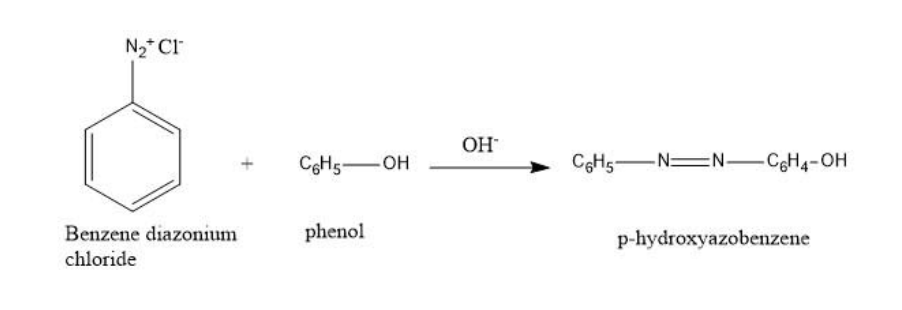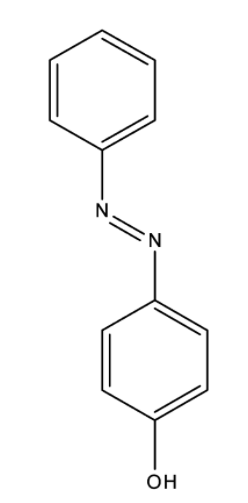
Benzene diazonium chloride on reaction with phenol in a basic medium gives:
A) diphenyl ether
B) p-Hydroxy azobenzene
C) chlorobenzene
D) benzene
Answer
486k+ views
Hint: When the concentration of OH- ion in solution is more, it is basic in nature. We call such a solution a basic medium.
Complete step by step answer:
Benzene diazonium chloride in reaction with phenol in a basic medium gives p-Hydroxy azobenzene.

So, out of the given options, B is the correct option, that is, p-Hydroxy azobenzene.
Additional information:
The structure of Benzene diazonium chloride is

And the structure of p-Hydroxy azobenzene is,

Benzene diazonium chloride has the chemical formula ${{\rm{C}}_{\rm{6}}}{{\rm{H}}_{\rm{5}}}{\rm{Cl}}{{\rm{N}}_{\rm{2}}}$. Benzene diazonium chloride is a salt of a chloride and diazonium cation. Benzene diazonium chloride exists as a colourless solid and it is soluble in polar solvents such as in water. It acts as the parent member of the aryl diazonium compounds. This compound is widely used in organic chemistry. As this salt is unstable, it is not available commercially but is prepared according to the demand. p-hydroxyazobenzene has chemical formula ${\rm{C}}{{\rm{l}}_{\rm{2}}}{{\rm{H}}_{{\rm{10}}}}{{\rm{N}}_{{\rm{20}}}}$ and has the atomic number 198.221. It has a density of $1.13{\rm{g/c}}{{\rm{m}}^{\rm{3}}}$, and has a boiling point of ${369.812^o}C$ and has a refractive index of 1.596.
The mechanism for the reaction of benzene diazonium chloride on reaction with phenol can be given as follows:

Note:
Benzene diazonium chloride has the chemical formula ${{\rm{C}}_{\rm{6}}}{{\rm{H}}_{\rm{5}}}{\rm{Cl}}{{\rm{N}}_{\rm{2}}}$. This compound is soluble in polar solvent and it exists as a colourless solid.
Complete step by step answer:
Benzene diazonium chloride in reaction with phenol in a basic medium gives p-Hydroxy azobenzene.

So, out of the given options, B is the correct option, that is, p-Hydroxy azobenzene.
Additional information:
The structure of Benzene diazonium chloride is

And the structure of p-Hydroxy azobenzene is,

Benzene diazonium chloride has the chemical formula ${{\rm{C}}_{\rm{6}}}{{\rm{H}}_{\rm{5}}}{\rm{Cl}}{{\rm{N}}_{\rm{2}}}$. Benzene diazonium chloride is a salt of a chloride and diazonium cation. Benzene diazonium chloride exists as a colourless solid and it is soluble in polar solvents such as in water. It acts as the parent member of the aryl diazonium compounds. This compound is widely used in organic chemistry. As this salt is unstable, it is not available commercially but is prepared according to the demand. p-hydroxyazobenzene has chemical formula ${\rm{C}}{{\rm{l}}_{\rm{2}}}{{\rm{H}}_{{\rm{10}}}}{{\rm{N}}_{{\rm{20}}}}$ and has the atomic number 198.221. It has a density of $1.13{\rm{g/c}}{{\rm{m}}^{\rm{3}}}$, and has a boiling point of ${369.812^o}C$ and has a refractive index of 1.596.
The mechanism for the reaction of benzene diazonium chloride on reaction with phenol can be given as follows:

Note:
Benzene diazonium chloride has the chemical formula ${{\rm{C}}_{\rm{6}}}{{\rm{H}}_{\rm{5}}}{\rm{Cl}}{{\rm{N}}_{\rm{2}}}$. This compound is soluble in polar solvent and it exists as a colourless solid.
Recently Updated Pages
Which of the following is not a function of the skeletal class 11 biology CBSE

The adiabatic bulk modulus of a diatomic gas at atmospheric class 11 physics CBSE

A tightrope walker in a circus holds a long flexible class 11 physics CBSE

How is ethane prepared in the laboratory class 11 chemistry CBSE

Why is there a need for the respiratory pigment in class 11 biology CBSE

The heating of phenylmethyl ethers with HI produces class 11 chemistry CBSE

Trending doubts
10 examples of friction in our daily life

One Metric ton is equal to kg A 10000 B 1000 C 100 class 11 physics CBSE

Difference Between Prokaryotic Cells and Eukaryotic Cells

State and prove Bernoullis theorem class 11 physics CBSE

What organs are located on the left side of your body class 11 biology CBSE

How many valence electrons does nitrogen have class 11 chemistry CBSE




